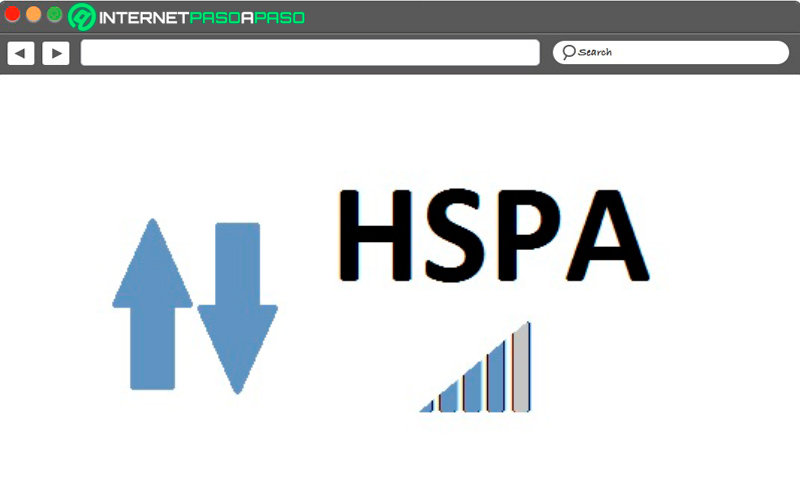
Index:
UPDATED ✅ Do you want to know more about what HSPA is and all its features and advantages in telecommunications? ⭐ ENTER HERE ⭐ and learn everything here
High Speed Packet Access or access to high-speed packetsis a telecommunications technology known as 3.5G, third generation (3G). it has been designed with the aim of improving what is UTMS technology (Universal Mobile Telecommunications System).
That is how HSPA works through two specific protocols that are used in tandemwhich help you to make your operation of high speed. All this has been converted into an improved version that allows extend and improve the performance of the networks of mobile companies.
If you still don’t fully know this HSPA technologythen here we are going to explain what it is about, its main function and what is its role in telecommunications, To do this, follow in detail everything that we will explain in this post.
What is HSPA and what is this technology used for in telecommunications?

Basically the HSPA is an update of what is the 3G UMTS which enables provide higher data rate being higher on both uplinks and downlinks. All this with the aim of improving performance and thus provide a best customer service.
So all of this was designed to be able to increase the capacity of Internet connectivity from smartphones in 3G, which are based on UMTS and WCDMA. Taking into account that the 3G UMTS was the one who allowed mobile communications they will go from a voice-centric system to a data-centric system.
Nevertheless, 3G UMTS speeds they weren’t quite enough for what it is browsing and downloading images and videosthat is why the need arose for improve this technology with HSPA. As mentioned above, it works with two specific protocolsas it is HSDPA which are the high-speed downlink packet accesses and the HSUPA, which are the high-speed uplink packets.
In the same way, this kind of HSPA networks are able to offer maximum of 14.4 megabytes per second of throughput. All this has undoubtedly made it a Improved version which allows you to provide a higher speed in Internet browsing from the mobile.
Evolution of HSPA What are all the versions and improvements of this technology that exist?
Like all technology, since the birth of the HSPA Different versions and improvements have been developed with the aim of keeping this system updated and capable of offer very good performance speeds.
That is why we are going to explain each of them below. These versions and what have been the improvements of each of them with respect to the previous one:
- HSPA: As already mentioned, HSPA was the first technology used with the aim of improve internet connections from mobilethus improving the UMTS standard. Since then, HSPA has been in constant evolution thanks to what has been the 3GPP standardization consortiumwho constantly allows performing techniques that serve to improve the standard.
- HSDPA: the second version that comes to continue improving all this Internet connectivity by telecommunications ends up being HSDPA, which breaks the limit UTMS 384 Kbpsthus providing a really good speed, considering that the most common speeds in the case of Spain they are 3.6Mbps and 7.2Mbps.
- HSUPA: With the aim of continuing to improve all this, it ends up developing HSUPA, It comes with the aim of further improve upload speed up to 5.7Mbps and in this way to be able reduce connection latency. In the case of Spain the most common speeds of this type are 1.4Mbps being able to arrive at 2 Mbps upload.
- HSPA+: After all this it ends up developing HSPA+ or HSPA Evolved as it is also known, this standard allows increase even plus the speed by modulating the data with 64QAM only in cases where the signal is really good. As usual, 64 QAM modulation carries more information with the same resources radioelectric.
This makes it possible to reach reach speeds up to 28Mbps download and of at least 11.5Mbps upload.
- HSPA+ MIMO: Finally, we find what is HSPA+ Mime, which is also called as the second phase of HSPA+. If that HSPA+ use MIMO can transmit via multiple signals in parallel managing to achieve like this a speed of up to 42 Mbps. something that allows further improve performance in telecommunications connections.
How does HSPA improve the UMT of 3G networks? Main advantages

Basically the HSPA was developed to become an improvement over to UMT standard with which they all work 3G networks. But in this case, the HSPA use more efficiently the radio spectrum that all operators are assigned. This is how, thanks to this technology, users can improve speeds and latency of data transfers offering like this better results in internet browsing.
That is how the UMTS was more geared towards the operation of switched circuits, This did not turn out to be quite suitable for packet operations, since users required higher speeds that were not within the reach of UMTS. Therefore, the HSPA was incorporated into many UMT networks so that they could operate better in the necessary applications.
All this offers a great number of benefits to usersone of them is that it allows them to have a better performance when using mobile connections. That is why here you we present the main advantages of this improvement in standards:
- Shorter Transmission Intervals (TTI): having a shortest TTIsignificantly reduces round trip timeswhich allows improve adaptation to rapid channel variations. In this way a reduction in latency can be provided.
- Using higher order modulation: In this case the 16QAM it’s used in HSDPA downlink so that the data can be transmitted to a high speedgetting to get speeds of up to 14 Mbps on these links. While the QPSK continue to use in HSUPA uplinks where can they get maximum speeds of up to 5.8 Mbps.
- The use of link adaptation: when it is achieved adapt the linkyou can maximize what is the use of the channel.
- Using shared channel streaming: Can share resources allows them to be achieve higher levels of efficiency and which are integrated with data packets and IP concepts.
- A quick node B schedule: Allows what is the use of quick programming with adaptive and encoded modulation that allows the system to respond to radio channel conditions and interference, only in the downstream channel. In this way, data traffic can be accommodated so that it tends to be transported faster.
- Hybrid ARQ based on Node B: This helps provide shorter round trip times. rebroadcast reduced and at the same time allows add robustness to the system so that smooth blending of retransmissions is allowed.
- Costs reduction: In the case of operators, with the implementation of this technology it is possible to achieve a reduction of costs per transported bit, and at the same time it allows to obtain a increase in system capacity. Therefore, as data traffic increases, operators increase revenues from data transmission, This resulted in something very positive for these companies.
- It can be incorporated through software updates: Finally, we find another advantage of this technologyand it is that the HSPA can be incorporated into software updates on the systemwhich means that it not only offers excellent benefits to operatorsbut also to users.
Terminals with HSPA In what type of equipment can we find this technology?
Not all devices have HSPA today, that’s why here we are going to show you which are the terminals in which you can find this technology and thus begin to make use of it:
Mobile
In the case of mobile devices, the large mobile phone companies already have various teams that include these capabilities as they are: HTC and HTC Touch Diamondas well as nokia which has models like N95. In the case of new 3G models that have come onto the market also tend to have including this technology in your system.
In the case of Spain exist four operators who offer this HSPA service in their mobile networksin this case it is Movistar, Vodafone, Yoigo and Orange. It’s like this here We show you a comparative table between each of them and their respective speeds according to the service:
| Operator | HSDPA | HSUPA | HSPA+ |
| Yoigo | 3.6Mbps | Yes | 21.6Mbps |
| Vodafone | 7.2Mbps | 5.76Mbps | 42Mbps |
| Movistar | 7.2Mbps | 5.76Mbps | 42Mbps |
| Orange | 14.4Mbps | 2Mbps | Nope |
4G USB sticks
Another way users can connect to an internet network is through usb modems. In general, each of them usually has a operator network and a specific speed. This is how they can currently be found. these types of devices with HSPA technologywhich provides better upload and download speeds to users.
So here we show you the most common modems that you will find in the market with this type of technology:
| Guy | download speeds | upload speeds | Observations |
| HSDPA modem | 3.6Mbps or 7.2Mbps | 384Kbps | When using WCDMA on the upstream, high latency is generated. |
| HSPA or HSUPA modem | 7.2Mbps | 2Mbps | |
| DC-HSPA+ modem | 42Mbps | 11.5Mbps | |
| HSPA+ modem | 21.6Mbps | 5.7Mbps |
Internet